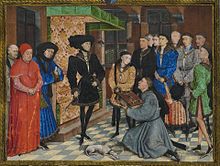Nicolas Rolin: Difference between revisions
Undid revision 1220097952 by 64.189.18.25 (talk) Restoring deleted material with French ref. |
So it makes sense. Tags: Reverted Visual edit Mobile edit Mobile web edit |
||
| Line 5: | Line 5: | ||
'''Nicolas Rolin''' ({{IPA|fr|nikɔla ʁɔlɛ̃}}; 1376–1462) was a leading figure in the history of [[Duchy of Burgundy|Burgundy]] and [[France]], becoming [[chancellor]] to [[Philip the Good]] (Philip III, [[Duke of Burgundy]]). |
'''Nicolas Rolin''' ({{IPA|fr|nikɔla ʁɔlɛ̃}}; 1376–1462) was a leading figure in the history of [[Duchy of Burgundy|Burgundy]] and [[France]], becoming [[chancellor]] to [[Philip the Good]] (Philip III, [[Duke of Burgundy]]). |
||
Born into a bourgeois family in [[Autun]], Rolin's first marriage in 1398 was part of a triple marriage of his [[widow]]ed mother to a [[bourgeois]] of [[Beaune]], accompanied by the marriages of her two sons to two daughters of the [[bridegroom]], Perrenet Le Mairet.<ref>{{cite book |last=Pridat |first=Herta-Florence |date=1996 |title=Nicolas Rolin, chancelier de Bourgogne |url= https://books.google.co.uk/books?id=r4wBEQAAQBAJ&pg=PA110 |publisher=Editions universitaires de Dijon |page=110 |isbn=9782905965110 }}</ref> |
Born into a bourgeois family in [[Autun]], Rolin's first marriage in 1398 was part of a triple marriage of his [[widow]]ed mother to a [[bourgeois]] of [[Beaune]], accompanied by the marriages of her two sons to two daughters of the [[bridegroom]], Perrenet Le Mairet.<ref>{{cite book |last=Pridat |first=Herta-Florence |date=1996 |title=Nicolas Rolin, chancelier de Bourgogne |url= https://books.google.co.uk/books?id=r4wBEQAAQBAJ&pg=PA110 |publisher=Editions universitaires de Dijon |page=110 |isbn=9782905965110 }}</ref> All three of his brides were dead within a few years. He next married Marie des Landes, before 1407, a marriage which paved the way for his entry into the [[Bourgeois of Paris|bourgeoisie of Paris]]. |
||
In 1422, Rolin was made chancellor by Philip the Good, a post he held for more than forty years as one of the principal architects of the monarch's success. Rolin is closely linked with [[John the Fearless]] who was [[Godparent|godfather]] to his third son. In 1421, Nicolas Rolin married [[Guigone de Salins]] (1403–1470) and together they established the [[Hospices de Beaune]]. Rolin was one of the participants in drafting the 1435 [[Congress of Arras|Treaty of Arras]] by which [[Charles VII of France|Charles VII]] recognised the independence of Burgundy, thus separating it from the English in the [[Hundred Years' War]]. One of the chancellor's sons, [[Jean Rolin (cardinal)|Jean Rolin]], was made [[bishop of Chalon-sur-Saône]] in 1431, and [[bishop of Autun]] in 1436. Jean became a Cardinal in 1448, created by [[Pope Nicholas V]], as part of diplomatic engagement between the Duchy of Burgundy and the Papacy. |
In 1422, Rolin was made chancellor by Philip the Good, a post he held for more than forty years as one of the principal architects of the monarch's success. Rolin is closely linked with [[John the Fearless]] who was [[Godparent|godfather]] to his third son. In 1421, Nicolas Rolin married [[Guigone de Salins]] (1403–1470) and together they established the [[Hospices de Beaune]]. Rolin was one of the participants in drafting the 1435 [[Congress of Arras|Treaty of Arras]] by which [[Charles VII of France|Charles VII]] recognised the independence of Burgundy, thus separating it from the English in the [[Hundred Years' War]]. One of the chancellor's sons, [[Jean Rolin (cardinal)|Jean Rolin]], was made [[bishop of Chalon-sur-Saône]] in 1431, and [[bishop of Autun]] in 1436. Jean became a Cardinal in 1448, created by [[Pope Nicholas V]], as part of diplomatic engagement between the Duchy of Burgundy and the Papacy. |
||
Revision as of 01:12, 22 April 2024

Nicolas Rolin (French pronunciation: [nikɔla ʁɔlɛ̃]; 1376–1462) was a leading figure in the history of Burgundy and France, becoming chancellor to Philip the Good (Philip III, Duke of Burgundy).
Born into a bourgeois family in Autun, Rolin's first marriage in 1398 was part of a triple marriage of his widowed mother to a bourgeois of Beaune, accompanied by the marriages of her two sons to two daughters of the bridegroom, Perrenet Le Mairet.[1] All three of his brides were dead within a few years. He next married Marie des Landes, before 1407, a marriage which paved the way for his entry into the bourgeoisie of Paris.
In 1422, Rolin was made chancellor by Philip the Good, a post he held for more than forty years as one of the principal architects of the monarch's success. Rolin is closely linked with John the Fearless who was godfather to his third son. In 1421, Nicolas Rolin married Guigone de Salins (1403–1470) and together they established the Hospices de Beaune. Rolin was one of the participants in drafting the 1435 Treaty of Arras by which Charles VII recognised the independence of Burgundy, thus separating it from the English in the Hundred Years' War. One of the chancellor's sons, Jean Rolin, was made bishop of Chalon-sur-Saône in 1431, and bishop of Autun in 1436. Jean became a Cardinal in 1448, created by Pope Nicholas V, as part of diplomatic engagement between the Duchy of Burgundy and the Papacy.

The house in which Rolin was born is now the Autun town museum and is known as the Musée Rolin. He owned the Château d'Oricourt and in 1435 he commissioned Jan van Eyck the famous The Virgin with Child and Chancellor Rolin, now at the Louvre. One of his sons was Cardinal Jean Rolin. Another son, Louis, was killed on the field at the battle of Grandson in 1476, while a third, Antoine, held various court offices such as chamberlain to Charles the Bold.
Having founded the Hospices de Beaune with his wife in 1443, in 1452 Rolin established a new religious order, "Les sœurs hospitalières de Beaune". He ordered the painting of an altarpiece, The Last Judgement by the Flemish painter Rogier van der Weyden for the hospices.
Sources
- Charles VII by Georges Minois
Parts of this article were initially translated from this Wikipedia article « fr:Nicolas Rolin », specifically from this version and from this Wikipedia article « fr:Guigone de Salins », specifically from [1].
External links
- ^ Pridat, Herta-Florence (1996). Nicolas Rolin, chancelier de Bourgogne. Editions universitaires de Dijon. p. 110. ISBN 9782905965110.
